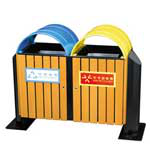
1.In Hangzhou, which bin should you put leftovers in?
A The grey lid bin.
B The red lid bin.
C The green lid bin.
D All of the above.
解析:选C。细节理解题。根据第二段的and the green lid bin for “green waste” such as grass and leaves可知,剩饭(可循环利用)要放入绿色垃圾桶,故选C。
2.What will local people probably get if they put daily rubbish into the new system in Zixinhuating Community?
A A computer.
B A car.
C A bin.
D Some small gifts.
解析:选D。细节理解题。根据第三段的Then I will get reward points to exchange for small gifts and even some money可知人们会得到积分来兑换小礼物,甚至一点钱,故选D。
3.Which of the following is NOT the consequence of burying rubbish?
A Polluting soil.
B Polluting water.
C Taking up a lot of land.
D Saving resources.
解析:选D。细节理解题。根据第五段Landfills take up a lot of land and have a risk of polluting the soil and water nearby.可知,填埋场会占用大量土地,有污染附近的土壤和水源的风险,故选D。
4.What does the passage mainly talk about?
A The history of a new rubbish sorting system.
B An introduction of a new rubbish sorting system.
C Economic benefits of a new rubbish sorting system.
D Rubbish bins in China.
解析:选B。主旨大意题。 本文一开始介绍杭州实行的一种新的垃圾分类方法,北京等地开始效仿。接下来讲为什么实施垃圾分类以及垃圾分类带来的经济效益,故选B。
5.In which part of a newspaper can you probably read the passage?
A Health.
B Culture.
C Education.
D Technology.
解析:选D。文章出处题。 新的垃圾分类需要用户扫描盖子上的二维码,然后给你积分,兑换礼品,这是一种新科技,故选D。